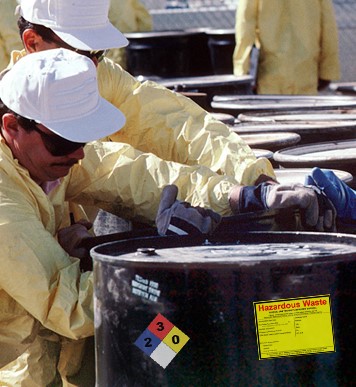 |
As part of the Occupational Safety and Health Administration’s (OSHA) Hazardous Waste Operations and Emergency Response (HAZWOPER) Site and Safety Plan requirements, employers/operators of hazardous waste sites must develop a decontamination plan and set it up before any employees or equipment enter areas where there is potential exposure to hazardous substances.
Decontamination Safety Six
Decontamination procedures should be tailored to the specific hazards of the site, and may vary in complexity and number of steps depending on the level of hazard and the employee’s exposure to the hazard. However, a hazardous waste site decontamination plan must contain these six steps.
Step 1: Determine the number and layout of decontamination stations. The number of decontamination stations needed will depend on the level of protection required. The maximum decontamination procedures for all levels consist of specific activities at 19 stations. Each station emphasizes an important aspect of decontamination (see tomorrow’s Advisor for more on decontamination stations).
HAZWOPER Training Program. You won’t find a more thorough and effective course related to hazardous waste operations to help meet the employee training requirements of OSHA’s HAZWOPER regulation (29CFR 1910.120). Learn More!
Step 2: Determine the decontamination equipment needed. Again, the equipment needed will depend on the level of protection required. For example, personal protective equipment (PPE) is divided into four categories or levels. Level A applies when the greatest level of skin, respiratory, and eye protection is required. Level B applies when the highest level of respiratory protection is required, but a lesser level of skin protection is needed. Level C applies when the concentration and type of airborne contaminant is known, and the criteria for using air purifying respirators are met. Level D requires a work uniform that provides minimal protection and is used for nuisance contamination only. This means that level D applies when the atmosphere contains no known hazard and work functions preclude splashes, immersion, or the potential for unexpected inhalation of or contact with hazardous levels of any chemicals.
Step 3: Determine appropriate decontamination methods. All employees, clothing, equipment, and samples leaving the contaminated area of a site must be decontaminated to remove any harmful chemicals or infectious organisms that may have adhered to them. Decontamination methods either:
- Physically remove contaminants by, for example, dislodging/displacement, rinsing, wiping off, and evaporation;
- Inactivate contaminants by chemical detoxification or disinfection/sterilization; or
- Remove contaminants by a combination of both physical and chemical means.
Step 4: Establish procedures to prevent contamination of clean areas. These standard operating procedures should include stressing work practices that minimize contact with hazardous substances (e.g., don’t walk through obvious areas of contamination); using remote sampling, handling, and container-opening techniques; protecting monitoring and sampling instruments by bagging; wearing disposable outer garments and using disposable equipment when possible; covering equipment and tools with a strippable coating that can be removed during decontamination; and encasing the source of contaminants (e.g., with plastic sheeting or overpacks).
Meet your OSHA-required 8-, 24-, or 40-hour HAZWOPER training requirements with HAZWOPER Training Program!
Step 5: Establish procedures to minimize contact with contaminants when removing PPE. Impermeable protective clothing that contacts or is likely to have contacted hazardous substances must be decontaminated before being removed by the employee. Employees whose permeable clothing becomes wetted with hazardous substances must immediately remove such clothing and proceed to the shower. The clothing must be disposed of or decontaminated before it is removed from the work zone. Use caution before removing clothing in an area with hazardous substances.
Step 6: Establish methods for disposing of clothing and equipment that are not completely decontaminated. All equipment used for decontamination must be decontaminated and disposed of properly. Buckets, brushes, clothing, tools, and other contaminated equipment should be collected, placed in containers, and labeled. Also, all spent solutions and washwater should be collected and disposed of properly. Clothing that is not completely decontaminated should be placed in plastic bags pending further decontamination or disposal.
Note. Commercial laundries or cleaning establishments that decontaminate protective clothing or equipment must be informed of the potentially harmful effects of exposure to hazardous substances.
Check tomorrow’s Advisor for a discussion of the “decontamination line” every hazardous waste site employee must be able to walk.
